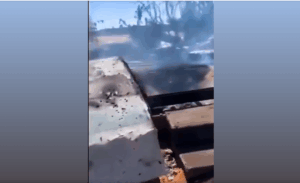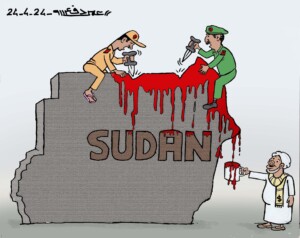15 confirmed dead in Sudan protest carnage
Overnight reports from the Central Committee of Sudan Doctors confirm that the death toll of civilians, after Sudan security forces fired on demonstrations with live ammunition yesterday, has risen to 15, while some of the wounded remain in critical condition. There have also been reports of security forces raiding hospitals and firing tear gas to prevent the wounded from being treated.
 Anti-coup demo in Khartoum on Wednesday (Mosaab Hassouna)
Anti-coup demo in Khartoum on Wednesday (Mosaab Hassouna)
Overnight reports from the Central Committee of Sudan Doctors confirm that the death toll of civilians, after Sudan security forces fired on demonstrations with live ammunition yesterday, has risen to 15, while some of the wounded remain in critical condition. There have also been reports of security forces raiding hospitals and firing tear gas to prevent the wounded from being treated.
Thousands of people took to the streets of Khartoum and other cities in Sudan yesterday in mass marches organised by resistance committees, to protest against the military coup d’état that seized power on October 25.
Medical authorities issued an urgent appeal to provide intravenous solutions and medical personnel to treat the injured at the International Hospital in Khartoum Bahri.
The Central Committee of Doctors of Sudan announced the death of Shakir Ali Abdelrahman (28) on Wednesday morning, as a result of being shot in the head on November 13, bringing the total number of fatalities since the October 25 military coup to 29.
In a separate appeal, the doctors’ committee “urgently calls upon the international community and the International Committee of the Red Cross to immediately intervene and rescue the wounded and provide the required equipment, medicines and supplies in response to the brutal ongoing attacks by the military in Sudan”.

The November 17 demonstrations called for by the Neighbourhood Committees of Khartoum North (Bahri), found ample response in the other parts of the Sudanese capital and other cities in the states in rejection of the military coup.
The protest marches moved in the three parts of the capital moved towards the main gathering points. Security forces using live ammunition and tear gas to disperse the protesters.
El Sitteen Street in Khartoum, El Shaheed Abdelazeem Street and streets in Karari in Omdurman, and El Haj Youssef and Bahri El Muasasa in Khartoum North, witnessed hit and run between the peaceful demonstrators and the military forces.
In an interview with Radio Dabanga’s Sudan Today programme, journalist Mohamed El Asbat said that the security forces adopted a new tactic by attacking the demonstrators before they gathered, and explained that the revolutionaries were able to change the planned routes.
He condemned the violent suppression of the protest marches, pointing to their continuation in Khartoum and a number of states.
The authorities pre-empted the November 17 demonstrations by cutting domestic telephone communications and text messaging services, and continuing to cut off the Internet, including via land lines, throughout the country. All bridges linking Khartoum, Omdurman and Khartoum Bahri were closed.
In the states, massive protest marches were launched in a number of cities, including Wad Madani in El Gezira, Atbara in River Nile state, El Fasher in North Darfur, Port Sudan in Red Sea state and other cities in response to the calls of the Resistance committees and in rejection of the military coup.
Demonstrators in Wad Madani said that the marches continued despite the attempts of repression and the firing of tear gas. Activists reported from El Fasher that the demonstrators took internal roads to avoid repression by the security services.
In Khartoum, protesters continued a one-day sit-in in Burri in Khartoum, and El Shaheed Abdelazeem Street in Omdurman, despite the excessive violence used by the military forces in the face of peaceful demonstrators.
The Sudanese Professionals Association condemned the excessive repression and the cordoning off of the revolutionaries’ marches in several areas, most notably in Khartoum Bahri, the area of El Sitteen Street in Khartoum, and streets in Ombadda in Omdurman, stressing that the demonstrators confirmed their ability to return and thwart the attacks of the security forces, to continue the activities of the marches in all their routes.











 and then
and then